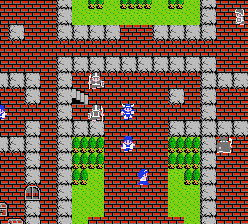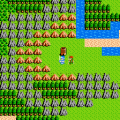- Dragon Quest (Introduction)
- Dragon Quest
- Dragon Quest II
- Dragon Quest III
- Dragon Quest IV: The Chapters of the Chosen
- Dragon Quest V: Hand of the Heavenly Bride
- Dragon Quest VI: Realms of Revelation
- Dragon Quest VII: Fragments of the Forgotten Past
- Dragon Warrior VIII: Journey of the Cursed King
- Dragon Quest XI: Echoes of an Elusive Age
- Slime Mori Mori Dragon Quest
- Dragon Quest Heroes: Rocket Slime
- Slime Mori Mori Dragon Quest 3
- Dragon Quest Heroes
- Dragon Quest Heroes II
By modern standards, the original Dragon Warrior is fairly archaic. At the beginning of the game, you’re a simple hero who’s charged with defeating the diabolical Dragonlord and reclaim the treasured Ball of Light. Along the way, you’ll need to slay a dragon to save the kidnapped princess. And that’s pretty much it as far as the plot goes. You can only control a single character in battle, and can only fight a single enemy at a time. This is the only NES Dragon Warrior with battles that actually features backgrounds – the others are fought against a black backdrop.
There are only a handful of spells – including two attack and two healing spells – and the only real strategy involves grinding so you’re strong enough to take down more powerful foes. About all you can do is grind until your character reaches level 30, at which point your hero’s stats are maxed out.
The graphics are ugly, the movement is clumsy, and the interface is cluttered with far more menus than necessary. It’s not enough to move over to a treasure chest to open it – you need to step on top of it, open a menu, and then select the “Check” command. The same thing goes with talking to people, opening doors and using stairs. The few caves you explore are completely dark, requiring that you bring a torch along. And even then, it only lights a single block around your character, so you’re still stumbling around blindly, at least until you get the spell later in the game that increase your sight. If you run out of either, you need to stumble around in the pitch black until you find an exit. You can only save the game at the king’s castle at the beginning of the game, although you can still heal at inns found throughout the land.
Still, in spite of its age, there are a few cool touches. Once you rescue the princess, you carry her from her jail cell all the way back to the castle, which feels pretty triumphant. Amusingly enough, the Dragonlord’s castle is visible from right across the river at the beginning of the game, but you need to travel the whole world in order to finally gain entrance. When you finally reach the Dragonlord, he gives you the option to switch sides and join him on his evil conquest. If you accept, he puts you to sleep, and the game freezes, requiring you to reset the console to start again.
Dragon Quest was originally released for the Famicom, and ported to the MSX shortly thereafter. It’s pretty much the same as the Famicom version, except your character always remains in the center, and the screen shifts around him whenever you move. It’s choppy and a bit distracting. The graphics and music are pretty similar, though there are some vague differences in quality. The MSX version has since become quite a collector’s item.
When Nintendo published the game in America three years later in 1989, they made a number of upgrades to make it a little less irritating. The graphics were improved slightly, adding extra details like shoreline tiles, which make it look a little bit less awful. It always looked kind of silly all of the characters looked like they were walking even when they were standing still, but the original Japanese version was even more ridiculous. The hero always faces downward regardless of what direction you’re moving in. It also caused other issues, like when you select “Talk” from the menu, you need to specify the direction of the person you want to talk to. In the English version, the hero has been redrawn and can now face in any of the four directions when walking – so even though it’s cumbersome as it is, it was much worse in the original Japanese version. The Japanese version also used passwords, which were replaced with a much simpler battery backup save system for the American release.
Nintendo put a lot of effort into its English translation, hoping that the massive success it found in Japan would be replicated overseas. All of the dialogue, including the battle narration, is written in old-style Elizabethan English (i.e. “Thou hast killed the slime!”), which might sound a little bit pompous and silly, but adds quite a bit of character. The translation is also significantly better than practically other NES game out there, probably because there’s a lot more text here than most video gamers were probably used to at the time. The spells were given completely different names – “Hoimi” became “Heal” and “Gira” became “Hurt”, with the more powerful spells becoming “Healmore” and “Hurtmore”. Many of the other names have changed too – the legendary hero “Loto” became known as “Erdrick”, and almost all of the town names are completely different. “Radatome Castle” became “Tantegel Castle”, “Radatome Town” became “Brecconary”, “Garai” became “Garinhaim”, “Maira” became “Kol”, and many others. “Alefgard” is the same in both versions.
The entire series has featured “puff puff” massage girls (in Dragon Quest, “pafu pafu” is onomatopoeia for a girl rubbing her breasts in someone’s faces, although in more general terms, it’s a girl juggling her own boobs), and this one featured a girl in the town of Maira/Kol offering a fun time for 50G. This was naturally removed from the NES game. The Toriyama illustrated cover was ditched in favor of some generic fantasy artwork of some little knight fighting a huge dragon. Much like The Legend of Zelda, Nintendo was unsure that its audience would understand this relatively complicated game, so it was also packaged with a full strategy guide that outlined the entire quest and mapped all of the mazes. Much of the artwork for these features were drawn by Katsuya Terada, and is quite excellent. It marks a good comparison point to how the game was marketed as “traditional” fantasy to Americans, versus the cartoonish manga art that defined the series in Japan.
Years later, Dragon Quest I was ported to the Super Famicom (released on the same cart with Dragon Quest II) using the engine from Dragon Quest V. This version, naturally only released in Japan, features all of the improvements made for the American version of the game like the battery save, along with enhanced graphics and sound. A lot of the music has been extended so it’s not quite as simplistic, which is definitely a plus. You also walk down stairs automatically and have a general “action” button to open treasure chests and talk to people. It still looks ancient, but at least it utilizes more colors. It makes grinding less annoying, since it increased the amount of experience and gold after each battle, and it also includes the stat enhancing seeds, which can be found by exploring in various spots. However, certain bosses have been made tougher, like the dragon guarding the princess. It also adds the vault found in the later games.
The Super Famicom port was also used as the basis for the Game Boy Color release, which was also bundled together with the second game. The graphics are similar, but obviously heavily downscaled for the portable platform. Still, it looks completely different than the original NES game, and arguably a bit better. Your characters also walk much faster. Fortunately, this version was translated into English, and reinstates many of the aspects that were censored in the NES release. “Erdrick” was also changed back to “Loto”. There’s also a brand new intro cinema.
The game was then ported to Japanese mobile phones in the mid-2000s. This version once again received redrawn graphics, done in the style of Dragon Quest VI and the Dragon Quest III remake. This was used for the basis of the smartphone iOS and Android versions, which were released in English, with a brand new translation and touch controls. The problem with the smartphone ports is that it uses a scaling algorithm that completely butchers the pixels, resulting in a remarkably ugly, jagged looking game.
Screenshot Comparisons
King’s Chambers
Overworld
Battle
Nintendo Power Scans
Links:
Source of Nintendo Power scans


